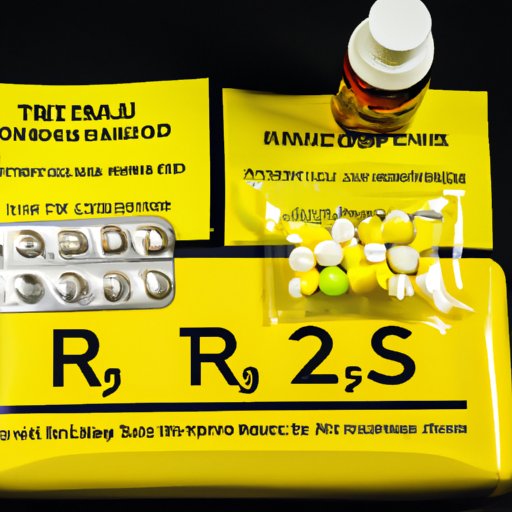
Introduction
Traveling can be stressful, especially when it comes to packing and bringing your medications on a plane. Whether you suffer from a headache, allergies, or a common cold, non-prescription medication can be crucial for your health and wellbeing while flying. However, some travelers have experienced difficulties when bringing non-prescription medication on a plane. In this article, we aim to provide you a comprehensive guide to help you understand what non-prescription medication you can bring on a plane and how to pack them properly.
Traveling with Medications: A Guide to Non-Prescription Drugs and Air Travel
Before we dive into the specific rules and regulations regarding non-prescription medication on a plane, it is important to know the general guidelines set by the Transportation Security Administration (TSA). Generally speaking, all medications, both prescription and non-prescription, are allowed on a plane. However, specific rules may apply, so it is crucial to be knowledgeable about the details.
There is a key distinction between prescription and non-prescription medication. Prescription medication, which is typically accompanied by a prescription from a licensed healthcare provider, must be kept in its original container and should be labeled with the passenger’s name, dosage, and the name of the prescribing doctor. On the other hand, non-prescription medication, which can be purchased over-the-counter without a prescription, does not require a prescription label, but it is still recommended to keep the medication in its original container.
When packing your non-prescription medication, it is crucial to keep them in their original container and to separate them from your other belongings. Generally, it is recommended to pack medications in your carry-on bag, as this will ensure that they are easily accessible to you throughout the flight. If you need to bring more medication than can fit in your carry-on bag, it is okay to pack some in your checked luggage.
Don’t Let Your Over-The-Counter Medications Derail Your Air Travel Plans – Here’s What You Need to Know
When it comes to non-prescription medication, some specific rules may apply, especially regarding liquids, gels, and aerosols.
Liquids, gels, and aerosols must follow the TSA’s 3-1-1 rule. This means that these items must be placed in a quart-sized clear plastic bag and that each individual container must not exceed 3.4 ounces. Medically necessary liquids, such as liquid medications and baby formula, are exceptions to the 3-1-1 rule and are allowed in larger quantities.
It is important to keep your medication easily accessible during your flight. One tip is to pack your medication in a small bag or pouch that you can keep in the seat pocket in front of you. This way, it is easy to access during the flight and does not require getting up and opening overhead bins.
TSA Regulations for Non-Prescribed Medicine while Traveling via Airplane
When traveling with non-prescription medication, it is crucial to know and follow the TSA regulations to avoid any potential issues at security checkpoints.
According to TSA regulations, non-prescription medication such as pain relievers, cough syrup, and allergy medication is allowed in both carry-on and checked baggage. This includes both solid and liquid medications. However, there are some limitations on the amount of medication you can bring on a plane.
If you are traveling with a large amount of non-prescription medication, it is a good idea to declare it to TSA agents at the security checkpoint. This can help avoid any potential confusion or issues at the checkpoint. It is recommended to pack all medication in a clear, sealable plastic bag and to separate it from your other belongings.
Packing your medicine before takeoff: Which non-prescription drugs to bring on a flight
If you are unsure which non-prescription medication to bring on your flight, here are some recommendations:
- Pain relievers – aspirin, acetaminophen, ibuprofen
- Antacids and digestive aids – Pepto-Bismol, Tums, Imodium
- Cold and allergy medication – antihistamines, decongestants, cough syrup
- Sleep aids – melatonin, Benadryl
- Topical medication – hydrocortisone cream, antibiotic ointment, lip balm
When choosing which medication to bring, it is important to consider your personal needs and preferences. For example, if you suffer from motion sickness, it may be a good idea to bring medication that can help alleviate your symptoms. Similarly, if you struggle to sleep on planes, a sleep aid may be helpful.
Remember, you do not need to bring every medication listed above – instead, prioritize based on your personal needs.
Pro Tips for getting through TSA with non prescribed medicines
If you are carrying non-prescribed medication through TSA security, here are some insider tips for making the process as stress-free as possible:
- Communicate with TSA agents – let them know that you are carrying medication and if there are any special instructions or needs.
- Bring documentation – if you are carrying a large amount of medication or are traveling internationally, it may be useful to bring a copy of your prescription or a letter from your doctor.
- Separate your medication – keep all medication in a transparent, sealable bag and separate it from your other belongings.
- Be patient and understanding – TSA agents are tasked with keeping passengers safe, so it is important to be patient and understanding if they ask questions or conduct additional screening.
Conclusion
Traveling with non-prescription medication can be stress-free if you know the rules and regulations. Remember to keep any over-the-counter medication in their original containers and separate them from your other belongings. Liquids, gels, and aerosols must follow the TSA’s 3-1-1 rule. There are also some limitations on the amount of medication you can bring, but as long as you follow TSA regulations and communicate with TSA agents, your travel experience should be smooth.





